 Long known as the city's most upscale market, Or Tor Kor Market is also probably my favourite place to shop in Bangkok. This has nothing to do with its chi-chi reputation; I've been shopping here since I moved to Bangkok in the late 90's, and the market has a great selection of just about everything, from high-quality ingredients to a decent dish of curry. It's relatively close to my house, and after a thorough renovation about three years ago, is now cleaner, better organized and more well-lit than ever. I've mentioned the market quite a few times on these pages, but have never really done blog specifically about it. I'm hoping to follow this up with profiles of some of Bangkok's other significant markets in the coming weeks.
Long known as the city's most upscale market, Or Tor Kor Market is also probably my favourite place to shop in Bangkok. This has nothing to do with its chi-chi reputation; I've been shopping here since I moved to Bangkok in the late 90's, and the market has a great selection of just about everything, from high-quality ingredients to a decent dish of curry. It's relatively close to my house, and after a thorough renovation about three years ago, is now cleaner, better organized and more well-lit than ever. I've mentioned the market quite a few times on these pages, but have never really done blog specifically about it. I'm hoping to follow this up with profiles of some of Bangkok's other significant markets in the coming weeks.
Or Tor Kor is mostly known for its giant--and often expensive--fruit, but you can pick up just about anything there, including veggies from this couple who've been selling at the market just as long as I can remember:

Tourists in particular are drawn to Or Tor Kor's selection of insanely immense shellfish, but at a markedly less impressive stall, Mr Sanyaa has been selling freshwater fish, the majority from the northern province of Nakhorn Sawan, for more than 10 years. He's incredibly enthusiastic about his products, voluntarily lifting and explaining the pedigree of each, and claims to sell only freshly caught (not raised) fish, including this meaty plaa buek (giant Mekong catfish):

If you're in no mood to cook, there's lots of prepared food you can take home delicious hor mok, steamed curries (shown at the top of this post) which, as shown above, tend to sell out pretty quickly, or a bag of curry to go from Mae Malee, an incredibly popular and longstanding curry stall just across the way:

If you can't wait until you make it home, there are lots of snacks too. Mr Tii has been making and selling his tasty khanom khrok, crispy coconut puddings, at Or Tor Kor for more than 25 years now:

He reckons the renovation has made the market better and has even improved his sales, as he's not located on the outermost edge any more. Mr Tii also claims that despite the rise in rent that came as a result of the renovation, most of the same vendors have remained and still sell their stuff at Or Tor Kor.
If you like Thai sweets, there are some delicious sticky rice treats:

and khanom taan, cornbread-like cakes of steamed palm sugar at Khanomthai Kao Peenong, a family-owned Thai sweets vendor that dominates the centre of the market.
You can also stop by Or Tor Kor for lunch or dinner, although there are better places in town to sit down to a meal, and anyway, there are never enough seats during the lunchtime rush. One reliable stall is Rot Det, whose tremendous variety of curries, soups and stir-fries have been available at Or Tor Kor for 'only about 10 years' according to one worker:

For a larger version of this image go here.
Steps away from Rot Det, I came across a stall I had never seen before, selling kung op woon sen, shrimp and glass noodles:

I had never noticed it before because it was new; less than a week old, confessed the owner. After recently graduating from a professional cooking course at Kasetsart University, she and her husband (and baby) decided to open up a stall at the market. Her take was deliciously peppery, but as she used margarine instead of the more traditional pork fat (a result of her Western-style cooking education, she explained), it lacked the richness I normally associate with kung op woon sen.
Another reason to visit the market is the abundance of regional Thai food. There at least four stalls selling various products from Thailand's north, and at least three stalls selling southern Thai food, including Jiap's, whose Phuket-style naam yaa pak tai, a fish-based coconut curry that is by far the mildest of all her excruciatingly spicy dishes, is pretty good:

The food of Thailand's northeast is represented by Sut Jai Kai Yaang, a stall (with an nearby, but noisy restaurant), that has served som tam and grilled chicken at Or Tor Kor for more than 30 years now:

They sell do-it-yourself som tam kits with everything you'd need (except the mortar and pestle--but those can also be bought nearby), something I'd never seen elsewhere.
In recent years, I've tended to visit Or Tor Kor primarily for its handsome branch of the Doi Kham or Royal Projects store, located directly east of the market. There you can get high-quality, Western-style produce grown in northern Thailand for ridiculously cheap. A recent visit revealed hard-to-find items such as sweet lemons, Italian parsley, rhubarb and smoked trout. At the west end of the market is another shop selling similar products from a different project; they have tiny bottles of wonderfully creamy goat milk and on occasion, a decent liver pate.
See the entire photoset of images from today's trip to Or Tor Kor Market here.
Or Tor Kor Market (Google Maps link)












 Besides some great lunch and dinner places in and around Mae Hong Son (one more of which I'll profile soon), there's also some interesting stuff to be had at breakfast and in the evenings. In the mornings, the city's market is by far the best place to fuel up:
Besides some great lunch and dinner places in and around Mae Hong Son (one more of which I'll profile soon), there's also some interesting stuff to be had at breakfast and in the evenings. In the mornings, the city's market is by far the best place to fuel up: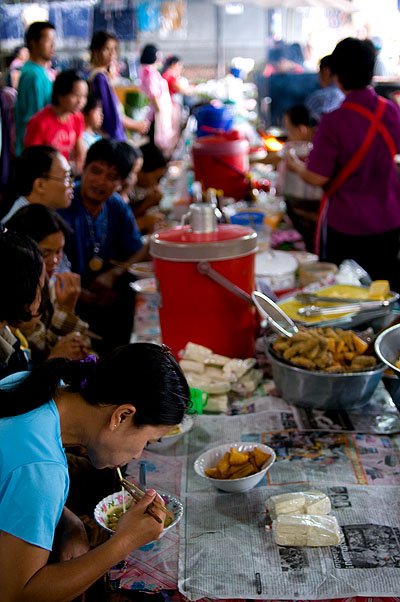



 Wat Jong Kham, Mae Hong Son
Wat Jong Kham, Mae Hong Son Tucked into the far northwestern corner of Thailand, remote Mae Hong Son is known more for its windy roads and Burmese-style temples than its food, but there's actually some pretty interesting stuff to eat here. One of my favourite places in the city is Baan Phleng.
Tucked into the far northwestern corner of Thailand, remote Mae Hong Son is known more for its windy roads and Burmese-style temples than its food, but there's actually some pretty interesting stuff to eat here. One of my favourite places in the city is Baan Phleng.




 Laap, minced meat mixed with roasted rice, lime juice, fresh herbs and fresh chili, has its origins in northeast Thailand and Laos, and is a dish known well outside the region. Laap as it's served in northern Thailand is an entirely dish altogether and is virtually unknown outside of the region. The most popular type among locals, laap khom, literally 'bitter laap' combines minced raw meat, typically beef, mixed with a curry paste and bitter bile from the stomach of a cow. It's easy to see why laap khom isn't going to be the next
Laap, minced meat mixed with roasted rice, lime juice, fresh herbs and fresh chili, has its origins in northeast Thailand and Laos, and is a dish known well outside the region. Laap as it's served in northern Thailand is an entirely dish altogether and is virtually unknown outside of the region. The most popular type among locals, laap khom, literally 'bitter laap' combines minced raw meat, typically beef, mixed with a curry paste and bitter bile from the stomach of a cow. It's easy to see why laap khom isn't going to be the next 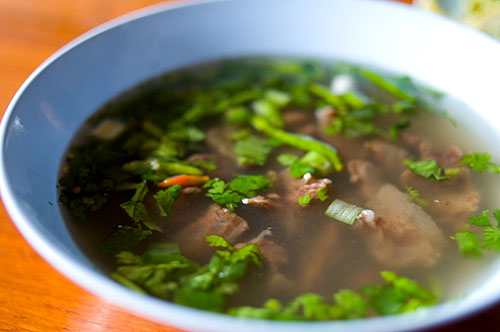
 This market, located behind Chiang Mai University, is probably the first Thai market I ever became familiar with. I was studying Thai at the university, and the market was a short walk from my apartment, also located lang mor ('behind the university'). I'd walk there to buy prepared food, and my first attempts at cooking Thai food were made with ingredients bought here. I still use the wok I bought there back in 1999. At the time I assumed Talaat Ton Phayom was like any typical market anywhere in Thailand. It wasn't until I learned more about Thai food and came back to the market later that I realized how local this market is. The vast majority of food sold there is specific to northern Thailand, and even as far as Chiang Mai markets go, this one is defiantly northern.
This market, located behind Chiang Mai University, is probably the first Thai market I ever became familiar with. I was studying Thai at the university, and the market was a short walk from my apartment, also located lang mor ('behind the university'). I'd walk there to buy prepared food, and my first attempts at cooking Thai food were made with ingredients bought here. I still use the wok I bought there back in 1999. At the time I assumed Talaat Ton Phayom was like any typical market anywhere in Thailand. It wasn't until I learned more about Thai food and came back to the market later that I realized how local this market is. The vast majority of food sold there is specific to northern Thailand, and even as far as Chiang Mai markets go, this one is defiantly northern.





 I've spent the last couple weeks upcountry, first in Chiang Mai and Mae Hong Son, then on a long drive along the west bank of the Mekong River all the back to Bangkok. While in Chiang Mai I really wanted to stop by a place that I'd eaten at years before, a late-night joint selling a variety of deep-fried meats and northern-style naam phrik or chili-based 'dips'.
I've spent the last couple weeks upcountry, first in Chiang Mai and Mae Hong Son, then on a long drive along the west bank of the Mekong River all the back to Bangkok. While in Chiang Mai I really wanted to stop by a place that I'd eaten at years before, a late-night joint selling a variety of deep-fried meats and northern-style naam phrik or chili-based 'dips'.
 Buddha figures for sale at a market in Mae Hong Son, Thailand.
Buddha figures for sale at a market in Mae Hong Son, Thailand. Yet another restaurant located way out in the wasteland of northern Bangkok, but after four recent visits, I reckon it's worth the drive. For starters, Crokmai Thai Lao has one of the most extensive menus of any isaan/Lao restaurant I've been to in Thailand. It has a full page dedicated to insects:
Yet another restaurant located way out in the wasteland of northern Bangkok, but after four recent visits, I reckon it's worth the drive. For starters, Crokmai Thai Lao has one of the most extensive menus of any isaan/Lao restaurant I've been to in Thailand. It has a full page dedicated to insects:




 What do you eat when you're on a Thai island with 11 former students? Food from the country's landlocked rural northeast, of course. Last weekend on Ko Samet this meant sticky rice, grilled chicken and many, many dishes of som tam (a salad of unripe papaya):
What do you eat when you're on a Thai island with 11 former students? Food from the country's landlocked rural northeast, of course. Last weekend on Ko Samet this meant sticky rice, grilled chicken and many, many dishes of som tam (a salad of unripe papaya):
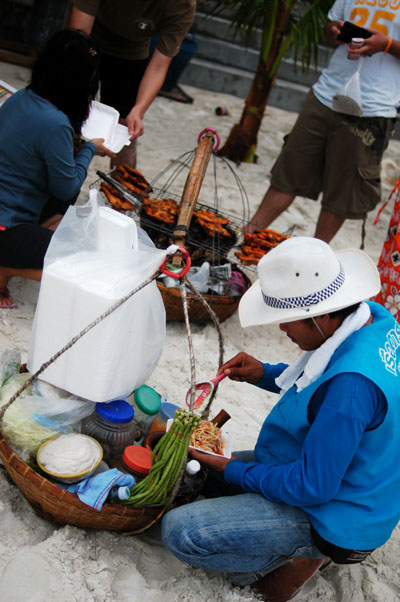

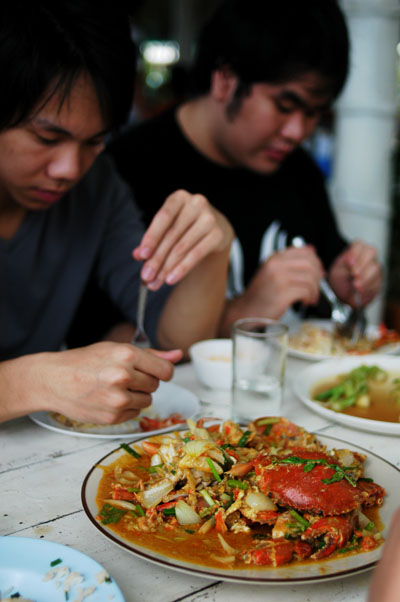


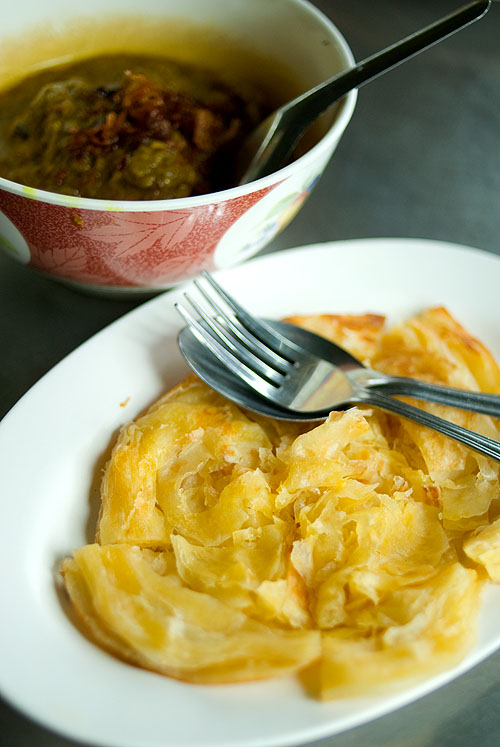 I've mentioned Yusup, a Muslim restaurant on the northern outskirts of Bangkok,
I've mentioned Yusup, a Muslim restaurant on the northern outskirts of Bangkok, 
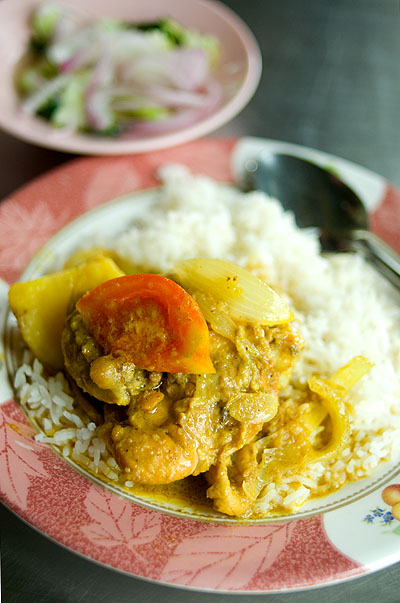


 After all this time, it looks like Thailand is set to get to be what appears to be a premium, domestically-made, and if the Gods are kind, drinkable beer: Federbräu. Brewed somewhat surreptitiously by ThaiBev (the brewers of Beer Chang) in Ayuthaya, the beer is a Blond Lager and contains 4.7% alcohol. Interestingly, many of the sites and blogs, not to mention the beer label itself, seem to make a point of mentioning that Federbräu is brewed following the famous Reinheitsgebot, ensuring its purity. But on a tour of a Singha Brewery a few years ago, the German-educated brewmaster ensured me that despite how it sometimes tastes, Singha also contains only water, barley, hops and yeast. Well, Singha had its chance, and iff they can get it right with Federbräu, I'll be switching loyalties very soon.
After all this time, it looks like Thailand is set to get to be what appears to be a premium, domestically-made, and if the Gods are kind, drinkable beer: Federbräu. Brewed somewhat surreptitiously by ThaiBev (the brewers of Beer Chang) in Ayuthaya, the beer is a Blond Lager and contains 4.7% alcohol. Interestingly, many of the sites and blogs, not to mention the beer label itself, seem to make a point of mentioning that Federbräu is brewed following the famous Reinheitsgebot, ensuring its purity. But on a tour of a Singha Brewery a few years ago, the German-educated brewmaster ensured me that despite how it sometimes tastes, Singha also contains only water, barley, hops and yeast. Well, Singha had its chance, and iff they can get it right with Federbräu, I'll be switching loyalties very soon.





















 In 2006 Krua Apsorn was chosen as one of the Bangkok Post's Best Restaurants (see clip
In 2006 Krua Apsorn was chosen as one of the Bangkok Post's Best Restaurants (see clip 



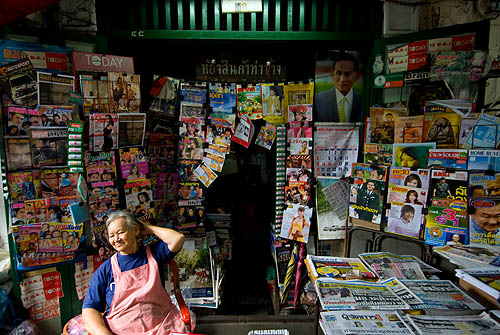 A newsstand at Tha Chang, Bangkok
A newsstand at Tha Chang, Bangkok
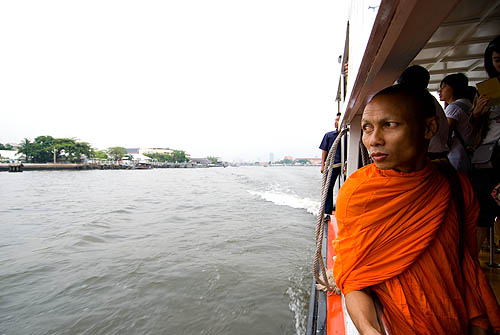

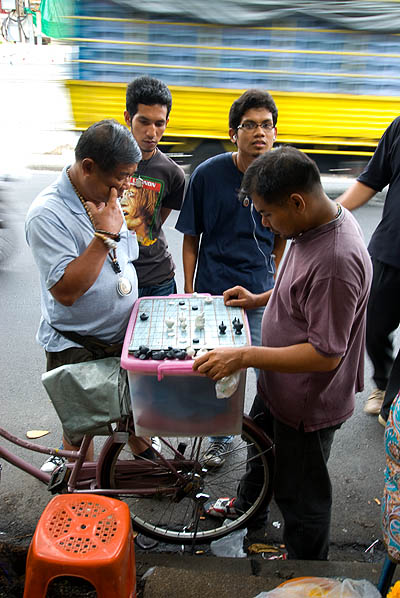
 \
\
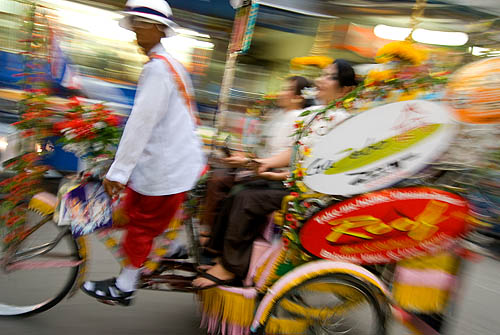
 The Nikon D300. Currently in waiting outside Chicago, USA. In my hands early May. For details, go in-depth reviews at
The Nikon D300. Currently in waiting outside Chicago, USA. In my hands early May. For details, go in-depth reviews at  Temple doors, Wat Ratchabophit.
Temple doors, Wat Ratchabophit.
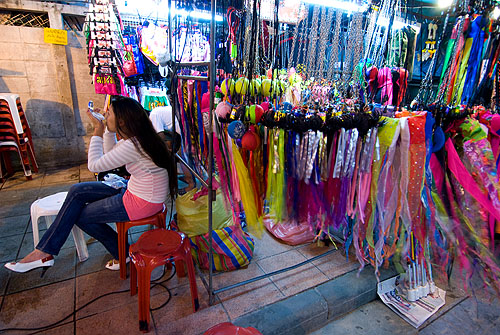

 Arguably Bangkok's most popular hawker stall, Naay Uan's recipe for success must lie in its simplicity. His kuay jap, a basic but delicious soup of of pork offal, thick rice noodles and broth draws literally hundreds of hungry diners to Chinatown every night:
Arguably Bangkok's most popular hawker stall, Naay Uan's recipe for success must lie in its simplicity. His kuay jap, a basic but delicious soup of of pork offal, thick rice noodles and broth draws literally hundreds of hungry diners to Chinatown every night:
 Bangkok, Thailand. ISO 2200.
Bangkok, Thailand. ISO 2200. Have you ever rented a car and driven to another province for a bowl of noodles? That's exactly what me,
Have you ever rented a car and driven to another province for a bowl of noodles? That's exactly what me, 